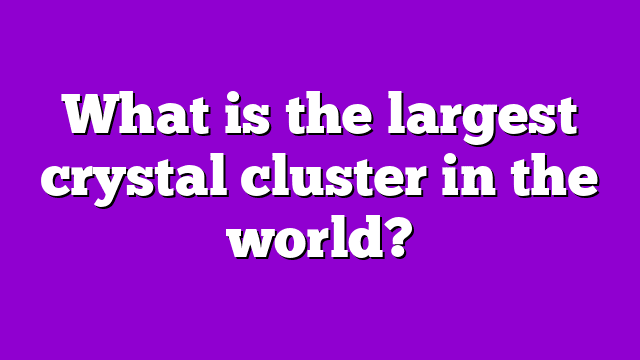Crystal Basics & Properties
What is the largest crystal cluster in the world?
The largest crystal cluster in the world is the Cave of Crystals or Cuevo de los Cristales in Naica, Mexico. It is a natural wonder that boasts massive selenite crystals measuring up to 39 feet (12 meters) long and weighing around 55 tons. Visitors are not allowed to enter the cave due to its extreme heat and humidity, but scientists have been studying it to learn more about the formation of crystals.
Crystal systems are groups of crystal structures that have common characteristics in terms of their shape, symmetry, and arrangement of atoms. There are seven crystal systems, each with unique features:
- Cubic system
- Tetragonal system
- Orthorhombic system
- Hexagonal system
- Trigonal system
- Monoclinic system
- Triclinic system
These crystal systems are important in the study of crystallography and can help determine the properties and behavior of crystals. Understanding the different crystal systems can also aid in the identification and categorization of various crystals.
Table Of Contents
The Origins of Crystal Clusters
- Crystals have been a part of human civilization for thousands of years, with various cultures valuing them for their beauty and alleged healing properties.
- A crystal cluster is a group of individual crystal points that grow together in close proximity, forming a larger rock structure.
- These structures are formed over millions of years, under varying conditions of temperature, pressure, and chemical composition.
- Crystal clusters can be found in various shapes, sizes, and colors, depending on the conditions under which they formed.
The Formation of Large Crystals
- Large crystals are formed under specific conditions, including slow cooling rates, high temperatures, and high pressure.
- Crystals can grow to enormous sizes over millions of years, with some reaching over 50 feet tall.
- Large crystal formations are often found in geologically active areas, such as volcanic regions or deep within the Earth’s crust.
- Despite their immense size, large crystal formations are incredibly fragile and can be easily damaged or destroyed by human interference.
The Discovery of the World’s Largest Crystal Cluster
- The world’s largest crystal cluster was discovered in 2000, in a mine in Naica, Mexico.
- The cluster was found in a cave system over 1000 feet below the Earth’s surface.
- Named the “Naica Giant,” the cluster measures over 36 feet in length, nearly 13 feet in height, and weighs several tons.
- The crystal cluster is made up of transparent selenite gypsum crystals, which are over 500,000 years old.
The Properties of the World’s Largest Crystal Cluster
- The Naica Giant is composed of thousands of individual crystal points, which are perfectly aligned and interlocked with one another.
- The crystals are almost completely transparent, with a slight yellow tint due to the presence of iron and other minerals.
- The crystal cluster is incredibly fragile, and its location in a hot and humid cave makes it difficult to preserve.
- The Naica Giant has been closed to the public since its discovery, in order to protect it from damage and deterioration.
Crystal Systems and Their Characteristics
- The study of crystal systems is a branch of mineralogy that focuses on the physical and chemical characteristics of crystals.
- There are seven different crystal systems, each with its own unique geometric structure and physical properties.
- The crystal systems are classified based on their symmetry and the angles between their crystal faces.
Exploring the Seven Crystal Systems
- The cubic crystal system is the most symmetrical, with perfect 90-degree angles between its faces.
- The tetragonal system has similar angles to the cubic system, but its crystals are elongated in one direction.
- The orthorhombic system has three unequal axes and no perfect 90-degree angles.
- The monoclinic system has one axis that is not perpendicular to the others.
- The triclinic system has axes of different lengths and angles that are not perpendicular.
- The trigonal system has one triangular axis and three equilateral axes that are not perpendicular.
- The hexagonal system has three equal axes that form a hexagonal shape, and one axis perpendicular to the others.
The Science Behind Crystal Formation
- The formation of crystals is a complex process that involves the interaction of various chemical and physical factors.
- Crystals form when atoms or molecules arrange themselves in a repeating pattern, creating a solid structure with a specific geometry.
- The conditions under which crystals form, such as temperature, pressure, and chemical composition, affect their size, shape, and physical properties.
- Crystal growth can also be influenced by external factors, such as the presence of impurities or the application of external stress.

